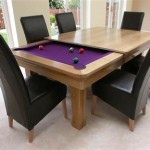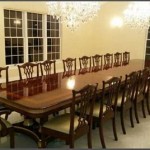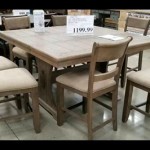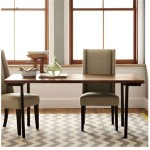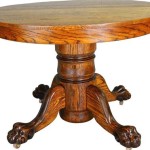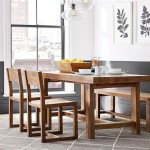Round Dining Table Glass Top: A Comprehensive Overview
The round dining table with a glass top has become a popular choice for modern homes, offering a blend of aesthetic appeal and functional benefits. This article explores the different aspects of round glass top dining tables, covering their design considerations, material options, advantages, potential drawbacks, and key factors to consider when selecting the right one for a specific space.
The popularity of round dining tables, in general, stems from their ability to promote conversation and create a more intimate dining experience. The circular shape eliminates the hierarchical structure often associated with rectangular tables, fostering a sense of equality and inclusivity among diners. When combined with a glass top, this shape becomes even more appealing, adding a touch of sophistication and modernity to any dining area. The transparency of the glass also allows for a better appreciation of the table's base, turning it into a focal point of the room.
Furthermore, round glass top dining tables are versatile and can complement various interior design styles. From minimalist and contemporary to mid-century modern and even some transitional spaces, the clean lines and reflective surface of the glass can adapt to different aesthetics. The choice of the table's base material and design, however, is crucial in ensuring that the table aligns seamlessly with the overall decor.
Design and Style Considerations
When choosing a round dining table with a glass top, design considerations are paramount. The style of the table should harmonize with the existing décor of the dining room or kitchen. The design entails several factors, including the size of the table, the type of glass used, the material of the base, and the overall aesthetic. A smaller table will suit a compact space, while a larger table can effectively anchor a more expansive dining area.
The thickness of the glass top is a significant factor to consider for both safety and aesthetics. Thicker glass is generally more durable and resistant to chipping or cracking. It also adds a more substantial and luxurious feel to the table. The edges of the glass should be carefully finished, preferably with a beveled or rounded edge, to prevent sharp corners and enhance safety, especially in households with children.
The base of the table plays a crucial role in defining the style and stability of the entire piece. Common materials for the base include wood, metal, and combinations of both. Wooden bases can provide a warm and organic feel, while metal bases offer a sleek and modern look. The design of the base can range from simple and minimalist to intricate and ornate, depending on the desired aesthetic. A pedestal base is a common choice for round tables, providing ample legroom and a clean, uncluttered look. Alternatively, a four-legged base can offer a more traditional and stable foundation.
Beyond the functional aspects, the design should also incorporate personal preferences and reflect the individual style of the homeowner. The possibilities are vast, from selecting a classic clear glass top to opting for a frosted or tinted glass that adds a touch of drama and privacy. Similarly, the base can be customized with different finishes, colors, and textures to create a truly unique and personalized piece.
Material Options and Durability
The materials used in the construction of a round dining table with a glass top significantly impact its durability, appearance, and overall value. The glass and the base materials have distinct characteristics to consider.
Typically, round glass top dining tables use tempered glass. Tempered glass is known for its strength and safety features. It is significantly more resistant to breakage compared to standard glass, and if it does break, it shatters into small, relatively harmless pieces, reducing the risk of serious injury. The thickness of the tempered glass can vary, typically ranging from 8mm to 12mm, with thicker glass offering greater durability and a more premium feel.
The type of glass can also vary in terms of clarity and finish. Clear glass is the most common choice, providing an unobstructed view of the table's base. However, frosted glass, tinted glass, and even etched glass can be used to achieve different aesthetic effects. Frosted glass provides a degree of privacy and can help to conceal minor imperfections or scratches. Tinted glass can add a touch of color and sophistication, while etched glass can create intricate patterns and designs.
As previously mentioned, common base materials for round glass top dining tables include wood, metal, and combinations of both. Wooden bases can range from hardwoods like oak, maple, and walnut to softwoods like pine. Hardwoods are generally more durable and resistant to scratches and dents, while softwoods are more affordable but require more care. Metal bases are typically made from steel, iron, or aluminum. Steel and iron bases offer excellent strength and stability, while aluminum bases are lightweight and rust-resistant. The finish of the metal base can also vary, with options including powder coating, chrome plating, and brushed finishes.
The combination of materials should be carefully considered to ensure both durability and aesthetic harmony. For example, a solid wood base with a clear glass top can create a warm and inviting feel, while a sleek metal base with a frosted glass top can evoke a more modern and minimalist aesthetic. Ultimately, the choice of materials will depend on the desired style, budget, and level of maintenance.
Advantages and Potential Drawbacks
Round dining tables with glass tops offer several advantages that contribute to their popularity. However, there are also potential drawbacks to consider before making a purchase.
One of the primary advantages of a glass top dining table is its aesthetic appeal. The transparency of the glass creates a sense of openness and lightness, making the dining area feel more spacious and airy. The glass also reflects light, brightening the room and adding a touch of elegance and sophistication. Furthermore, a glass top allows for a better appreciation of the table's base, which can be a design feature in its own right. The shape of a round table promotes conversation and engagement between diners, making it ideal for family gatherings and social events.
Another advantage is the ease of cleaning and maintenance. Glass surfaces are generally easy to wipe clean with a damp cloth and mild detergent. They are also resistant to staining and water damage, making them a practical choice for dining areas where spills are common. The smooth surface of the glass prevents food particles from getting trapped, ensuring a hygienic dining environment.
However, glass top dining tables also have some potential drawbacks. One common concern is the visibility of fingerprints and smudges. Glass surfaces tend to show fingerprints and smudges more readily than other materials, requiring frequent cleaning to maintain a pristine appearance. The sound of dishes and utensils on glass can also be a concern for some people. The clinking and scraping sounds can be amplified by the glass surface, creating a potentially noisy dining experience. This can be mitigated by using placemats and tablecloths.
Another potential drawback is the perceived fragility of glass. While tempered glass is durable and resistant to breakage, some people may still be hesitant to use it in a high-traffic area, especially if they have young children. The edges of the glass can also be vulnerable to chipping or cracking, requiring careful handling to prevent damage. Finally, glass top dining tables can be more expensive than tables made from other materials, such as wood or laminate.
Ultimately, the decision of whether or not to purchase a round dining table with a glass top will depend on individual preferences, lifestyle, and budget. Weighing the advantages and disadvantages carefully will help to make an informed decision and select a table that meets the needs and expectations of the user.
Key Factors to Consider When Selecting the Right Table
Choosing the right round dining table with a glass top requires careful consideration of several factors to ensure that the table meets the specific needs of the user and fits seamlessly into the dining space.
The size of the dining area is a crucial factor. Before purchasing a table, measure the dimensions of the room and consider the available space around the table. Allow for at least 36 inches of space between the table and the walls or other furniture to ensure comfortable movement and prevent overcrowding. A table that is too large will make the room feel cramped and uncomfortable, while a table that is too small may not be functional enough for the user's needs.
The number of people who will typically use the table is another important consideration. A smaller round table may be sufficient for a couple or a small family, while a larger table may be necessary for larger families or those who frequently entertain guests. As a general guideline, allow for at least 24 inches of space per person at the table to ensure comfortable seating and adequate elbow room.
The overall style and decor of the dining area should also be taken into account. The table should complement the existing furniture and accessories in the room. Consider the color scheme, materials, and design elements to create a cohesive and harmonious look. A modern and minimalist dining area may benefit from a sleek glass top table with a metal base, while a more traditional dining area may be better suited to a table with a wooden base and a thicker glass top.
The budget is also a significant factor to consider. Round dining tables with glass tops can range in price from a few hundred dollars to several thousand dollars, depending on the materials, design, and brand. Set a budget before starting the shopping process and stick to it to avoid overspending. Consider the long-term value and durability of the table when making a purchase decision. A higher-quality table may cost more upfront but will likely last longer and require less maintenance over time.
Finally, consider the maintenance requirements of the table. Glass tops require regular cleaning to maintain their pristine appearance. Choose a table with a glass that is easy to clean and resistant to scratches and stains. The base material should also be easy to care for. Wooden bases may require occasional polishing or refinishing, while metal bases may require occasional cleaning to prevent rust or corrosion.

Furniture Of America Jasmin Glass Top Round Dining Table With Black Base Parks Home Furnishings

Furniture Of America Jacreme Glass Top Round Dining Table Silver

Dovetail Judy Round Dining Table

Jensen Round Dining Table 42

Irene Frosted Tempered Glass Round Dining Table Set

Larson Round Glass Dining Table 48

Saloom Furniture K Base Round Dining Table Glass Top 2modern

Skorpio Round Dining Table

Nantucket Round Dining Table W Glass Top Regina Andrew

Crystal Round Dining Table

